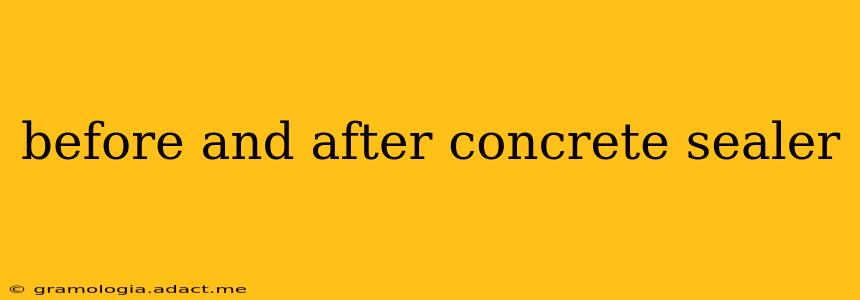Concrete is a durable and versatile material, widely used for driveways, patios, walkways, and more. However, exposure to the elements can leave concrete looking dull, stained, and prone to damage. Concrete sealer acts as a protective barrier, enhancing its appearance and extending its lifespan. This guide explores the dramatic transformations possible with concrete sealer, highlighting the before-and-after differences and addressing common questions.
What are the noticeable differences before and after applying concrete sealer?
The transformation is often quite striking. Before sealing, concrete might appear porous, dusty, stained (from oil, grease, or other spills), and perhaps even cracked or crumbling in places. The color might be faded and uneven. After sealing, the concrete will appear significantly richer in color, often appearing darker and more vibrant. The surface will be smoother, less porous, and easier to clean. The sealer also protects against future staining and damage from weathering.
How does concrete sealer improve the look of concrete?
Concrete sealer works in several ways to improve the aesthetic appeal:
- Enhances Color: Sealer deepens the natural color of the concrete, bringing out its inherent beauty.
- Reduces Staining: By sealing the pores, the sealer prevents liquids from penetrating the concrete, minimizing staining.
- Creates a Uniform Appearance: It evens out the surface, reducing the appearance of imperfections and creating a more polished look.
- Adds a Gloss or Sheen (Depending on the Sealer): Some sealers add a glossy finish, while others provide a more matte or satin look, depending on the desired aesthetic.
What are the practical benefits of using concrete sealer besides aesthetics?
Beyond the visual improvements, concrete sealer offers significant practical benefits:
- Protection from Weathering: It shields the concrete from water damage, freeze-thaw cycles, and UV degradation, prolonging its lifespan.
- Increased Durability: A sealed surface is more resistant to cracking, chipping, and abrasion.
- Easier Cleaning: Sealed concrete is much easier to clean; spills wipe away easily without staining.
- Resistance to Chemicals: Some sealers offer enhanced resistance to chemicals like oil and gasoline.
What types of concrete sealers are available?
Several types of concrete sealers cater to different needs and aesthetics:
- Acrylic Sealers: These are water-based, environmentally friendly, and offer good protection. They are commonly used for driveways and patios.
- Epoxy Sealers: These are more durable and resistant to chemicals but are more expensive and require professional application. They are suitable for high-traffic areas or those subject to harsh chemicals.
- Siloxane Sealers: These penetrate deep into the concrete, providing excellent protection against moisture. They are often preferred for porous concrete.
How long does concrete sealer last?
The lifespan of concrete sealer varies depending on the type of sealer, the climate, and the amount of foot or vehicle traffic. Generally, sealers can last anywhere from 1 to 5 years, with some high-quality options lasting even longer. Regular inspection and reapplication are recommended to maintain optimal protection and appearance.
What are some common mistakes to avoid when sealing concrete?
- Applying Sealer to Damp Concrete: Ensure the concrete is completely dry before applying any sealer.
- Ignoring Preparation: Proper cleaning and surface preparation are crucial for optimal adhesion and results.
- Using the Wrong Type of Sealer: Choose a sealer appropriate for the type of concrete and intended use.
- Over-Applying Sealer: Following the manufacturer's instructions regarding application rate is crucial to prevent excessive build-up and potential peeling.
Conclusion
Applying concrete sealer can dramatically transform the look and longevity of your concrete surfaces. From drab and stained to vibrant and protected, the before-and-after results often speak for themselves. By understanding the different types of sealers and following best practices, you can ensure your concrete surfaces remain beautiful and functional for years to come. Remember to always consult the manufacturer's instructions for the specific product you choose.
